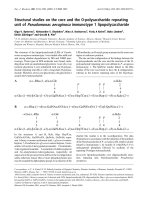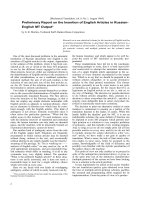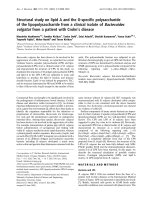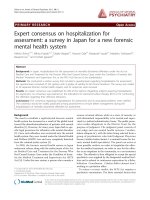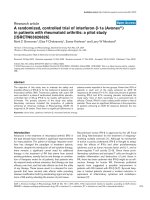Báo cáo y học: "Case report on trial: Do you, Doctor, swear to tell the truth, the whole truth and nothing but the trut" ppt
Bạn đang xem bản rút gọn của tài liệu. Xem và tải ngay bản đầy đủ của tài liệu tại đây (794.11 KB, 3 trang )
JOURNAL OF MEDICAL
CASE REPORTS
Case report on trial: Do you, Doctor, swear to tell
the truth, the whole truth and nothing but the
truth?
Yitschaky et al.
Yitschaky et al. Journal of Medical Case Reports 2011, 5:179
(13 May 2011)
EDI T O R I A L Open Access
Case report on trial: Do you, Doctor, swear to tell
the truth, the whole truth and nothing but the
truth?
Oded Yitschaky
1
, Michael Yitschaky
1
and Yehuda Zadik
2,3*
Abstract
We are in the era of “evidence based medicine ” in which our knowledge is stratified from top to bottom in a
hierarchy of evidence. Many in the me dical and dental communities highly value randomized clinical trials as the
gold standard of care and undervalue clinical reports. The aim of this editorial is to emphasize the benefits of case
reports in dental and oral medicine, and encourage those of us who write and read them.
Editorial
We live today in the era of “evidence based medicine” ,
in which our knowledge is stratified from top to bottom
in a hierarchy of evidence [1-3]. At the pinnacle of this
hierarchy we find randomized clinical trials, systematic
reviews and meta-analyses, which are supposed to be
the cream and cherry of medical-scientific-modern
knowledge. Far below at the bottom of the pyramid we
find case reports, which are often barely regarded as evi-
dence. The aim of this editorial, however, is to empha-
size the benefits of case reports, and encourage those of
us who write and read them.
Randomized clinical trials are expensive, take years to
conduct, and ma y encounter ethical problems, such as
knowingly withholding treatment from a sample of
patients. It is true that randomized clinical trials can
give us a statistical answer for very narrow clinical ques-
tions, which can guide us when treating the “average
patient” (i.e. the patient who comes with only the speci-
fic medic al problem). As clinicians we know that most
of our questions are not clearly answered in a rando-
mized clinical trial, and many clinical questions cannot
be answered. Clinical trials may be hindered by ethical
restraints [4], financial limitations, and statistical factors;
in some rare medical syndromes [5,6], it may be impos-
sible to collect adequate samples to conduct a rando-
mized clinical trial. With this in mind, it is interesting
to read the Collins and Pinch report about how azi-
dothymidine was approved as effective tre atment for
Acquired Immune Deficiency Syndrome (AIDS), even
though the randomized clinical trials were stopped by
the social and political pressure of AIDS activists [7].
One of the methodological requirements of a rando-
mized clinical trial is double blindness, which means
that both the patient and the physician do not know if
that patient is receiving the treatment being evaluated
or a placebo substitute. In 1997, Shapiro and Shapiro
asked the question “How blind is blind?”, and claimed
that in randomized clinical trials the doctor can differ-
entiate between true drug and placebo in about 80% of
the cases, and the patient can differentiate in about 70%
of the cases [8].
The case report can be published quickly [9], and be
authored by busy clinicians who see patients on a daily
basis and do not have the time or money to conduct large
scale research. In our humble opinion, the experience of
these clinicians is valuable infrastructure on which medical
knowledge can be built. Additionally, randomized clinical
trials can only inspect one variable or very few variables at
the most and rarely reflect the full picture of a complicated
medical situation. The case report can detail many differ-
ent aspects of the pat ient’s medical situation, specifically
including patient history, physical examination, psychoso-
cial aspects, follow up, etc.
With regards to the question: “can the medical com-
munity learn from one case?” , our answer is that the
medical community must learn from any case, especially
those that are particularly unusual. These cases will give
* Correspondence:
2
Oral Medicine, Hebrew University-Hadassah School of Dental Medicine, P.O.
Box 91120, Jerusalem, Israel
Full list of author information is available at the end of the article
Yitschaky et al. Journal of Medical Case Reports 2011, 5:179
/>JOURNAL OF MEDICAL
CASE REPORTS
© 2011 Yitsch aky et al; licensee BioMed Central Ltd. This is an Open Access article distributed under the terms of the Creative
Commons Attribution License ( which permits unrestricted use, distribution, and
reproduction in any medium, provided the original work is prope rly cited.
us, as clinicians, better insight into the unusual riddles
which we usually encounter in our everyday practice.
Let us leave the “hierarchy” for the bureaucratic institu-
tions and the “evidence” for the court-rooms, and use
our imagination and intuition - which are well docu-
mented in interesting case reports - to help us better
treat our patients.
Author details
1
Departments of Orthodontics, Oral Medicine, Hebrew University-Hadassah
School of Dental Medicine, P.O.Box 91120, Jerusalem, Israel.
2
Oral Medicine,
Hebrew University-Hadassah School of Dental Medicine, P.O.Box 91120,
Jerusalem, Israel.
3
Editorial Board, Journal of Medical Case Reports.
Authors’ contributions
OY, MY and YZ conducted this Editorial together.
Competing interests
The authors declare that they have no competing interests.
Received: 28 October 2010 Accepted: 13 May 2011
Published: 13 May 2011
References
1. Guyatt GH, Sackett DL, Sinclair JC, Hayward R, Cook DJ, Cook RJ: User’s
guides to medical literature: IX. A method for grading health care
recommendations. JAMA 1995, 274:1800-1804.
2. Sackett DL: Evidence based medicine: what it is and what it isn’t. BMJ
1996, 312:71-72.
3. King M: Impact of participant and physician intervention preferences on
randomized trials. JAMA 2005, 293:1089-1099.
4. Kidd MR, Hrynaszkiewicz I: Journal of Medical Case Reports’ policy on
consent for publication. J Med Case Reports 2010, 4:173.
5. Will TA, Agarwal N, Petruzzelli GJ: Oral cavity metastasis of renal cell
carcinoma: a case report. J Med Case Reports 2008, 2:313.
6. Lakshminarayanan V, Ranganathan K: Oral melanoacanthoma: a case
report and review of the literature. J Med Case Reports 2009, 3:11.
7. Collins H, Pinch T: Dr. Golem - How to Think About Medicine. Chicago:
The University of Chicago Press; 2005, 153-179.
8. Shapiro AK, Shapiro E: The power of placebo - from ancient priest to
modern physician. Baltimore: John Hopkins University Press; 1997, 190-216.
9. Kidd M, Hubbard C: Introducing journal of medical case reports. J Med
Case Reports 2007, 1:1.
doi:10.1186/1752-1947-5-179
Cite this article as: Yitschaky et al.: Case report on trial: Do you, Doctor,
swear to tell the truth, the whole truth and nothing but the truth?
Journal of Medical Case Reports 2011 5:179.
Submit your next manuscript to BioMed Central
and take full advantage of:
• Convenient online submission
• Thorough peer review
• No space constraints or color figure charges
• Immediate publication on acceptance
• Inclusion in PubMed, CAS, Scopus and Google Scholar
• Research which is freely available for redistribution
Submit your manuscript at
www.biomedcentral.com/submit
Yitschaky et al. Journal of Medical Case Reports 2011, 5:179
/>Page 2 of 2
